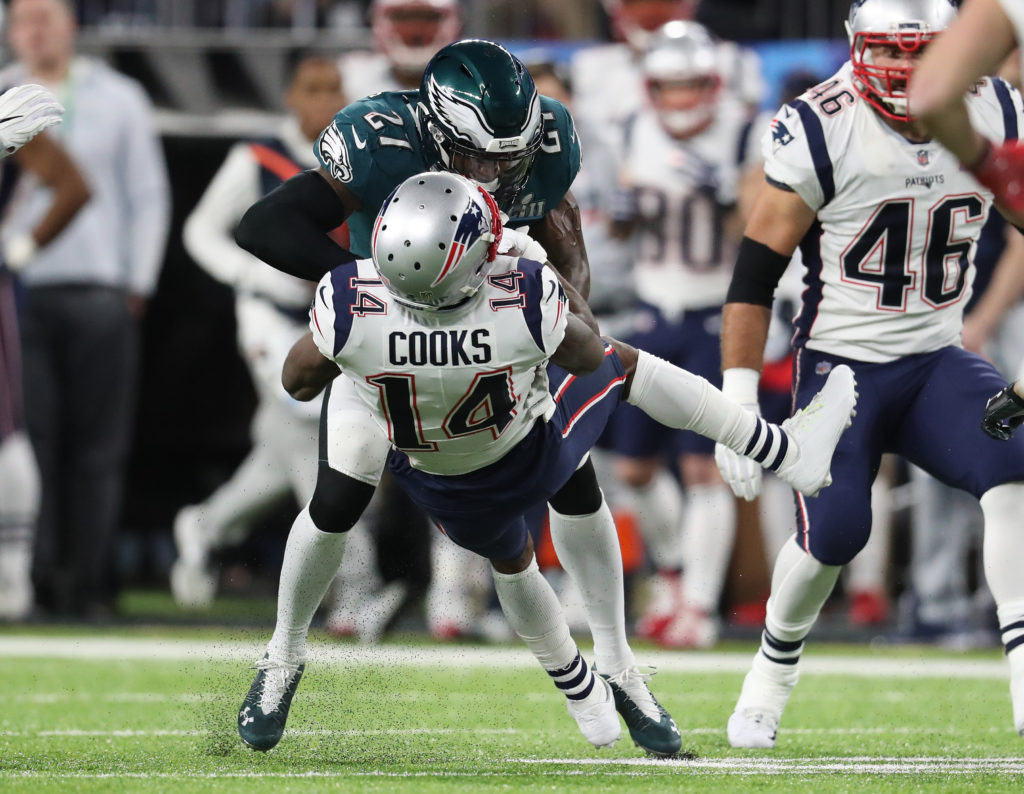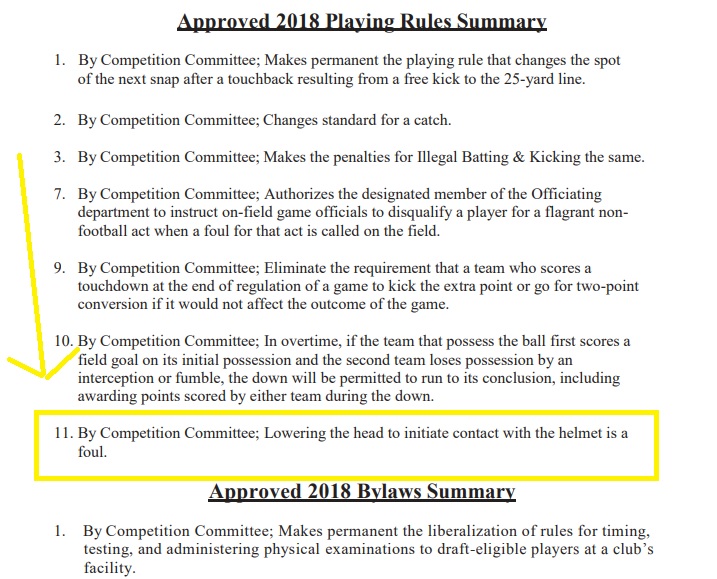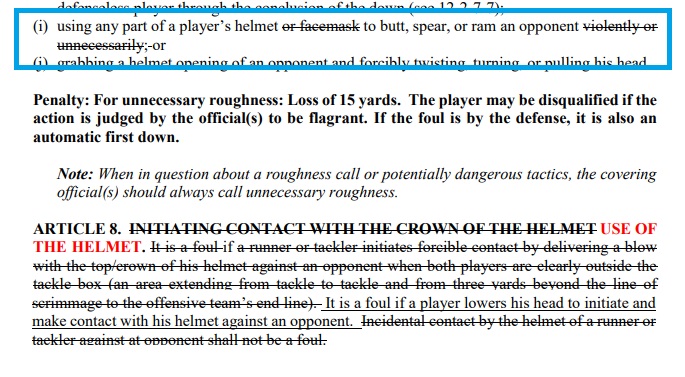Ad Disclosure
Is this Now an Illegal Hit? Confusion Over the NFL’s New Helmet Rule

Death, taxes, and the ambiguity that comes with new NFL rules.
These are life’s certainties.
Regarding the latter, players seem a bit miffed by the rollout of new guidelines that redefine the legal and illegal use of the helmet.
Problem is, there really aren’t any guidelines. Similar to the language defining “what is a catch,” there’s a vagueness that leaves us somewhere in the middle, resulting in confusion and putting the burden on referees to decide how to proceed.
In the approved 2018 playing rules summary, the new rule is simple defined as you see below:
“Lowering the head to initiate contact with the helmet is a foul,” is the most simple explanation.
When you go further down the summary, you see the rule added via amended language as to what constitutes “unnecessary roughness” –
So the old 2013 “crown” rule is struck out and being replaced with generic language that penalizes the use of the helmet to “butt, spear, or ram” an opponent.
That’s too generic for some players, who feel like they don’t have a clear grasp of what the NFL wants.
Each year, referees will visit NFL teams to meet with players and coaches and give a presentation to explain the rule changes for the coming season. This time around, members of both the Eagles defense and offense didn’t come away with a full understanding of what is and isn’t allowed.
“We were trying to ask questions to get a better understanding, and yet they couldn’t really give us an answer,” linebacker Nigel Bradham said. “They couldn’t give us what we were looking for.”
….
During the presentation, which lasted close to an hour according to Bradham, players were shown clips of what are now considered illegal hits — some of which appeared to them as routine tackles.
Seeking further clarification during the Q&A that followed, the players showed the presenters a video of safety Malcolm Jenkins’ hit on wide receiver Brandin Cooks during Super Bowl LII that knocked Cooks out of the game. The refs were split on whether it would now be considered an illegal hit.
“I’m going to make that play 10 times out of 10. If it’s a flag, it’s a flag,” Jenkins said after practice Sunday, adding that he doesn’t believe that hit would lead to an ejection under the current policy. “You can’t slow yourself down thinking about rules in a split second. The game happens really, really fast, faster than the rules, I think, take account for, but I won’t let it affect the way I play.”
Running back Matt Jones is also quoted in the article, explaining that helmet-to-helmet hits for downhill ball carriers are nearly impossible to avoid. It’s a problem for players on the offensive side of the ball as well, not just defenders.
The NFL did put out a video a while back showing how they might enforce the rule:
Today owners approved the ejection standards to go along with the Use of the Helmet rule. Here’s the rule explained with video examples from the 2017 @NFL season. pic.twitter.com/Dzs4EWGVdx
— NFL Football Operations (@NFLFootballOps) May 22, 2018
Two of those clips looked like clean tackles to me, but a couple were totally unnecessary.
In the video, the NFL explains that ejection standards will be based on whether the offending player had an unobstructed path to his opponent, if contact was clearly avoidable, or if they establish “linear body posture.”
For what it’s worth, the player opinions don’t seem to mesh with Doug Pederson’s take on the new rules, as he made it seem like the coaching staff got a full understanding from the referee presentation.
That’s my takeaway from these three quotes from Saturday’s post-practice availability:
Q. Do you feel like the rules that were implied to you are clear, and it’s clear from the NFL’s end what you’re being asked to do? (Mike Tanier)
DOUG PEDERSON: Yes, I do. I do. It’s been well-communicated to us, and it’s our job to communicate to our players these rules. That’s why we bring the officials in like we do. Especially in the beginning of training camp, so our guys can be exposed to some of the new changes.
Q. Have you heard from defensive players who are concerned at all about these new rules? (Mike Tanier)
DOUG PEDERSON: No, not really. It’s just — a lot of them is just point of emphasis. Things that we talk about, we just have to make — talk about them a little bit more.
Q. Back to the rules for a second. Have you changed a lot from previous years as coaches? Do you have to take more time this year than other seasons to sort of explain the changes? (John McMullen)
DOUG PEDERSON: We did spend a little time with the officials that are here this week the other night, just to clarify some things. And it’s really a nice forum for our team to ask questions. If there is something that they’re not familiar with or not sure of, and it’s just any rule. But my job is to make sure that our guys are well-educated on the points of emphasis, the new rule changes. And then our coaches are well-versed, and so we can continue to communicate and teach our players when we’re out here on the field.
I guess it’s one thing for Pederson to understand the guidelines but another for his players to have to execute that on the field. You always hear from guys who say it’s incredibly difficult to slow down or avoid certain hits or shift your momentum at the last minute. In the case of Jenkins’ hit on Cooks, Jenkins is only one half of the play. If Cooks ducks or shifts or moves, maybe he ends up in a position that would make Jenkins hit illegal. That’s not to say it was intended to be that way, but any defensive player could have the intention of making a clean hit and face issues trying to adjust at the last minute to avoid leading with the helmet.
Either way, it might be a bit of a rough rollout period for the new rule, with different refereeing crews deciding to call it in different ways. Like it or not, this is where we’re headed in the modern day NFL.
Malcolm Jenkins’ hit on Brandin Cooks in Super Bowl is now considered illegal by some refs under new rule: pic.twitter.com/69l6ilWUou
— Tim McManus (@Tim_McManus) July 29, 2018
Kevin has been writing about Philadelphia sports since 2009. He spent seven years in the CBS 3 sports department and started with the Union during the team's 2010 inaugural season. He went to the academic powerhouses of Boyertown High School and West Virginia University. email - k.kinkead@sportradar.com

